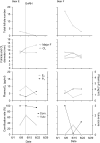Monitoring follicular dynamics to determine estrus type and timing of ovulation induction in captive brown bears (Ursus arctos)
- PMID: 33041275
- PMCID: PMC7768176
- DOI: 10.1262/jrd.2020-044
Monitoring follicular dynamics to determine estrus type and timing of ovulation induction in captive brown bears (Ursus arctos)
Abstract
It is important to understand ovarian physiology when developing an artificial insemination (AI) protocol. Brown bears (Ursus arctos) have a breeding season from May to July, although the type of estrus (polyestrus or monoestrus) is still contested. The present study aimed to define the ovarian dynamics, including follicular waves and ovulatory follicle size, and estrus type in brown bears. Six brown bears were used for ovarian ultrasonography; four were observed between April and October (before the start and after the end of the breeding season) and two in June (breeding season). In addition, we attempted to induce ovulation by administering a gonadotropin releasing hormone (GnRH) agonist. We observed follicular development in April in four bears, but follicles did not develop to greater than 6.0 mm in diameter until May. Thereafter, a group of follicles developed to more than 6.0 mm and grew as dominant follicles, except in one bear. After ovulation and subsequent corpus luteum (CL) formation, the follicular waves disappeared. Furthermore, in three bears treated with GnRH, follicles between 8.2 to 11.2 mm in diameter at the time of treatment ovulated and formed CLs. In two bears, follicles between 5.8 to 8.8 mm ovulated spontaneously within the observation interval. Our results suggest that brown bears may be monoestrous animals. Therefore, AI can only be performed once during the breeding season. Our results also suggest that dominant follicles larger than 8.0 mm are a suitable size for inducing ovulation.
Keywords: Brown bear; Estrus type; Follicular dynamics; Ovulation induction; Ultrasonography.
Figures




References
-
- IUCN.2019. The IUCN Red List of Threatened Species. Version 2019-2. http://www.iucnredlist.org. Downloaded on 18 July 2019.
-
- McLellan BN, Proctor MF, Huber D, Michel S.Ursus arctos (amended version of 2017 assessment). The IUCN Red List of Threatened Species 2017: e.T41688A121229971.
-
- Anel L, Álvarez M, Martínez-Pastor F, Gomes S, Nicolás M, Mata M, Martínez AF, Borragán S, Anel E, de Paz P. Sperm cryopreservation in brown bear (Ursus arctos): preliminary aspects. Reprod Domest Anim 2008; 43(Suppl 4): 9–17. - PubMed
-
- Anel L, Gomes-Alves S, Alvarez M, Borragan S, Anel E, Nicolas M, Martinez-Pastor F, de Paz P. Effect of basic factors of extender composition on post-thawing quality of brown bear electroejaculated spermatozoa. Theriogenology 2010; 74: 643–651. - PubMed
-
- Ishikawa A, Matsu M, Sakamoto H, Katagiri S, Takahashi Y. Cryopreservation of the semen collected by electroejaculation from the Hokkaido brown bear (Ursus arctos yesoensis). J Vet Med Sci 2002; 64: 373–376. - PubMed
MeSH terms
Substances
LinkOut - more resources
Full Text Sources
Miscellaneous

